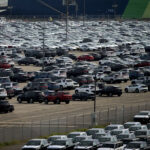Collision repair shops are taking a hit.
Today’s automobiles are safer, fuel-efficient and generally more technologically advanced than vehicles built years ago. Those strides have resulted in an array of on-board gadgetry that is costly to replace after a crash. In many cases, insurance companies cut their losses and will designate a vehicle as “totaled.”
“There does seem to be more of that than it used to be,” said Terry Larson, owner of Terry Larson Insurance in Huntington. He said when a repair bill is more than a car’s current market value, the insured usually is handed a check for the vehicle’s worth.
“Repair costs are very expensive. If you were to completely wreck a $25,000 car, it would cost almost double to replace it.”
In some cases, today’s higher-quality vehicles are holding their value longer, resulting in fewer being totaled, officials said.
State Farm Insurance is the largest carrier in the nation and insures one in four vehicles in Indiana. From 2005 to 2010 the company had nearly 100,000 “totals,” a 14 percent decline, compared to the previous five-year span, spokeswoman Missy Lundberg said.
The value of cars involved in claims is rising. CCC Information Services, a claims management consultant in Chicago, said total-loss values increased 4.5 percent at mid-year 2010, compared with the same period a year ago.
And then there are traffic statistics revealing the impact of better-made vehicles. Estimates released this month by the National Highway Traffic Safety Administration show the number and rate of U.S. traffic fatalities in 2010 at their lowest levels since 1949.
Government leaders say safer vehicles are a major reason for the drop, which bodes well for some body shops. A Bureau of Labor Statistics study shows employment of automotive body repairers likely will grow by 1 percent by 2018. The analysis, however, points to several factors that will limit the growth.
For example, bureau researchers said increasingly advanced technology used in vehicles has indeed led to “significant increases in the prices of new and replacement parts.”
“Collision repair shop owners, in an effort to stay profitable, have adopted productivity enhancing techniques. The result of this has also been consolidation within the industry, or a decreasing number of collision repair shops and limited total employment growth,” the report stated.
“In some cases, the use of new technology . has led to more cars that are involved in accidents to be declared a total loss – where repairing a car costs more than the value of the vehicle. High insurance deductibles have meant that an increasing number of cars suffering minor collision damage are going un-repaired.”
Regional and state industry watchers agree.
“There’s so much sophistication and technology in the cars today,” said Jason Stahl, editor of BodyShop Business, a trade publication in Akron, Ohio. “Every since the third brake light in the window of cars was introduced, we’ve seen less crashes and the roads are safer.”
According to the Indianapolis-based Indiana Auto Body Shop Association, there are about 1,100 repair businesses statewide and up to 40,000 nationwide. The number shrinks about 4 percent to 5 percent annually, the organization says.
“The cars are built better, so it does seriously impact the number of vehicles that are fixed,” said Dick Fox, owner and president of Fox & Fox Frame Service Inc. in Fort Wayne.
“Certainly, the cost is a lot higher because of the all the restraint equipment. You just don’t have an air bag in the steering wheel anymore. There are side-curtain bags, the electronics and sensors. You can have a fairly new car and still have to total it out.”
Ranie Taranta, owner of Indiana International Collision Inc., said insurance companies prefer dealing with “centralized” repair shops because they can monitor work flow better.
“That means the bigger boys with more capacity will be the ones they will be calling on,” said Taranta, whose operation is in Fort Wayne. “The little shops won’t be around anymore. Everybody knows that there are going to be less and less of us around.”
Taranta thinks he has a niche market because he works on foreign vehicles.
“That was why I chose the name I did,” he said.
Stahl said, “With the economy the way it is, nobody is safe. Some people are just pocketing the insurance money and are willing to drive around with” a banged-up vehicle, he said. “It could be a little blemish or in some cases a big blemish.”
Consumers in other countries also don’t mind having vehicles in less than mint condition, said Tony Passwater, executive director of the Indiana Auto Body Shop Association. He said those buyers covet American-made cars but can’t afford the tariffs, which can add 50 percent of the vehicle cost to the price tag.
“They would gladly buy a vehicle that has been salvaged because it is (taxed) as auto parts instead of the full price of a vehicle,” Passwater said.
“They don’t have the safety requirements that we do over here, so they don’t have to replace those (air bags) and other restraints.”
Passwater said the foreign market has opened a new customer base for insurers who in recent years have had to “total” 20 percent or more of their clients’ vehicles.
“That number used to be in the single digits,” he said.
Was this article valuable?
Here are more articles you may enjoy.

 OpenAI And Microsoft Sued Over Murder-Suicide Blamed on ChatGPT
OpenAI And Microsoft Sued Over Murder-Suicide Blamed on ChatGPT  Storm Goretti Batters Europe With Violent Winds, Power Cuts
Storm Goretti Batters Europe With Violent Winds, Power Cuts  US Auto Sales Poised to Slip as Middle-Class Buyers Retreat
US Auto Sales Poised to Slip as Middle-Class Buyers Retreat  California Bill Would Require Insurer Claims Handling Plans, And Double Penalties
California Bill Would Require Insurer Claims Handling Plans, And Double Penalties 